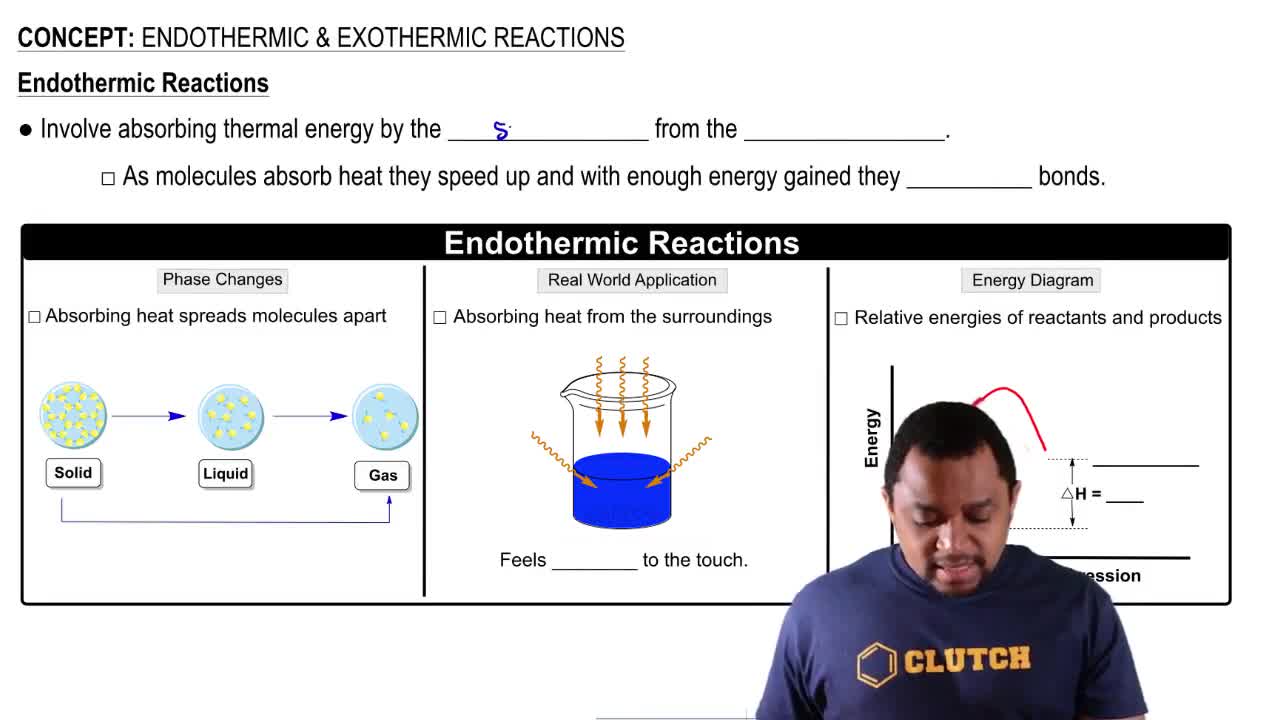Sulfur tetrafluoride 1SF42 reacts slowly with O2 to form sulfur tetrafluoride monoxide 1OSF42 according to the following unbalanced reaction: SF41g2 + O21g2¡OSF41g2 The O atom and the four F atoms in OSF4 are bonded to a central S atom. (a) Balance the equation.
Ch.9 - Molecular Geometry and Bonding Theories
Chapter 9, Problem 114c
Sulfur tetrafluoride (SF4) reacts slowly with O2 to form sulfur tetrafluoride monoxide (OSF4) according to the following unbalanced reaction: SF4(g) + O2(g) → OSF4(g) The O atom and the four F atoms in OSF4 are bonded to a central S atom. (c) Use average bond enthalpies (Table 8.3) to estimate the enthalpy of the reaction. Is it endothermic or exothermic?
 Verified step by step guidance
Verified step by step guidance1
Identify the bonds broken and formed in the reaction. In SF_4, the bonds are S-F, and in O_2, the bond is O=O. In OSF_4, the bonds are S=O and S-F.
Use the average bond enthalpies from Table 8.3 to find the energy required to break the bonds in the reactants. Calculate the total energy for breaking 4 S-F bonds and 1 O=O bond.
Use the average bond enthalpies to find the energy released when forming the bonds in the products. Calculate the total energy for forming 1 S=O bond and 4 S-F bonds.
Calculate the enthalpy change of the reaction (ΔH) by subtracting the total energy of bonds formed from the total energy of bonds broken: ΔH = (Energy of bonds broken) - (Energy of bonds formed).
Determine if the reaction is endothermic or exothermic. If ΔH is positive, the reaction is endothermic (absorbs heat). If ΔH is negative, the reaction is exothermic (releases heat).

Verified video answer for a similar problem:
This video solution was recommended by our tutors as helpful for the problem above.
Video duration:
9mWas this helpful?
Key Concepts
Here are the essential concepts you must grasp in order to answer the question correctly.
Bond Enthalpy
Bond enthalpy, or bond dissociation energy, is the energy required to break one mole of a specific type of bond in a gaseous substance. It is a crucial concept in thermochemistry as it helps estimate the energy changes during chemical reactions. By using average bond enthalpies, one can calculate the total energy required to break bonds in reactants and the energy released when new bonds are formed in products.
Recommended video:
Guided course

Enthalpy of Formation
Enthalpy Change (ΔH)
The enthalpy change (ΔH) of a reaction is the difference in enthalpy between the products and the reactants. It indicates whether a reaction absorbs heat (endothermic, ΔH > 0) or releases heat (exothermic, ΔH < 0). Calculating ΔH involves summing the bond enthalpies of the bonds broken and formed, providing insight into the energy dynamics of the reaction.
Recommended video:
Guided course

Enthalpy of Formation
Exothermic vs. Endothermic Reactions
Exothermic reactions release energy to the surroundings, often in the form of heat, resulting in a temperature increase in the environment. In contrast, endothermic reactions absorb energy, leading to a temperature decrease. Understanding the nature of the reaction in question helps predict its behavior and the energy changes involved, which is essential for determining the reaction's enthalpy.
Recommended video:
Guided course

Endothermic & Exothermic Reactions
Related Practice
Textbook Question
Textbook Question
Sulfur tetrafluoride (SF4) reacts slowly with O2 to form sulfur tetrafluoride monoxide (OSF4) according to the following unbalanced reaction: SF4(g) + O2(g) → OSF4(g) The O atom and the four F atoms in OSF4 are bonded to a central S atom. (b) Write a Lewis structure of OSF4 in which the formal charges of all atoms are zero.
Textbook Question
Sulfur tetrafluoride 1SF42 reacts slowly with O2 to form sulfur
tetrafluoride monoxide 1OSF42 according to the following
unbalanced reaction:
SF41g2 + O21g2¡OSF41g2
The O atom and the four F atoms in OSF4 are bonded to a
central S atom.
(e) For each of the molecules you drew in part (d), state how many
fluorines are equatorial and how many are axial.
1
views
Textbook Question
The phosphorus trihalides 1PX32 show the following variation in the bond angle X¬P¬X: PF3, 96.3°; PCl3, 100.3°; PBr3, 101.0°; PI3, 102.0°. The trend is generally attributed to the change in the electronegativity of the halogen. (b) What is the general trend in the X¬P¬X angle as the halide electronegativity increases?
